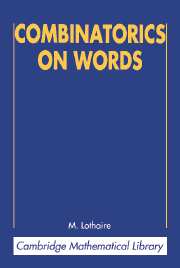Book contents
- Frontmatter
- Contents
- Foreword
- Preface
- Preface to this edition
- Chapter 1 Words
- Chapter 2 Square-Free Words and Idempotent Semigroups
- Chapter 3 Van der Waerden's Theorem
- Chapter 4 Repetitive Mappings and Morphisms
- Chapter 5 Factorizations of Free Monoids
- Chapter 6 Subwords
- Chapter 7 Unavoidable Regularities in Words and Algebras with Polynomial Identities
- Chapter 8 The Critical Factorization Theorem
- Chapter 9 Equations in Words
- Chapter 10 Rearrangements of Words
- Chapter 11 Words and Trees
- Bibliography
- Index
Chapter 6 - Subwords
Published online by Cambridge University Press: 04 November 2009
- Frontmatter
- Contents
- Foreword
- Preface
- Preface to this edition
- Chapter 1 Words
- Chapter 2 Square-Free Words and Idempotent Semigroups
- Chapter 3 Van der Waerden's Theorem
- Chapter 4 Repetitive Mappings and Morphisms
- Chapter 5 Factorizations of Free Monoids
- Chapter 6 Subwords
- Chapter 7 Unavoidable Regularities in Words and Algebras with Polynomial Identities
- Chapter 8 The Critical Factorization Theorem
- Chapter 9 Equations in Words
- Chapter 10 Rearrangements of Words
- Chapter 11 Words and Trees
- Bibliography
- Index
Summary
Introduction
Let us recall the definition: a word f in A* is a finite sequence of elements of A, called letters. We shall call a subword of a word f any sequence contained in the sequence f. The word aba for instance is a subword of the word bacbcab as well as of the word aabbaa. It can be observed immediately that two sub-sequences of f, distinct as subsequences, may define the same subword: thus aba is a subword of bacbcab in only one way but may be obtained as a subword of aabbaa in eight different ways.
A word f being given it is easy to compute the set of its subwords and their multiplicity; this computation is obtained by a simple induction formula. The main problem of interest in this chapter, sometimes implicitly but more often explicitly, is the one of the inverse correspondence. Under what conditions is a given set of words S the set of subwords, or a subset of certain kind of the set of subwords, of a word f? Once these conditions are met, what are the words f that are thus determined? In which cases are they uniquely determined? Some of these conditions on that set S are rather obvious. For instance if g is a subword of f, then any subword of g is a subword of f.
- Type
- Chapter
- Information
- Combinatorics on Words , pp. 105 - 142Publisher: Cambridge University PressPrint publication year: 1997
- 3
- Cited by



